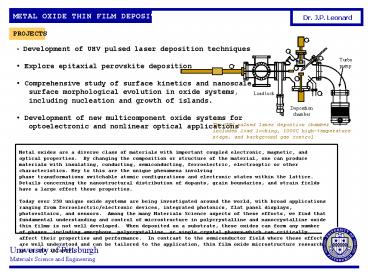University of Pittsburgh - PowerPoint PPT Presentation
1 / 4
Title:
University of Pittsburgh
Description:
... of Pittsburgh. Materials Science and Engineering. METAL OXIDE THIN ... Among the many Materials Science aspects of these efforts, ... Materials Science and ... – PowerPoint PPT presentation
Number of Views:267
Avg rating:3.0/5.0
Title: University of Pittsburgh
1
METAL OXIDE THIN FILM DEPOSITION
Dr. J.P. Leonard
PROJECTS
- Development of UHV pulsed laser deposition
techniques - Explore epitaxial perovskite deposition
- Comprehensive study of surface kinetics and
nanoscale - surface morphological evolution in oxide
systems, - including nucleation and growth of islands.
- Development of new multicomponent oxide systems
for - optoelectronic and nonlinear optical
applications
The UHV pulsed laser depostion chamber includes
load locking, 1000C high-temperature stage, and
background gas control
Metal oxides are a diverse class of materials
with important coupled electronic, magnetic, and
optical properties. By changing the composition
or structure of the material, one can produce
materials with insulating, conducting,
semiconducting, ferroelectric, electrooptic or
other characteristics. Key to this are the unique
phenomena involving phase transformations
switchable atomic configurations and electronic
states within the lattice. Details concerning
the nanostructural distribution of dopants, grain
boundaries, and strain fields have a large effect
these properties. Today over 250 unique oxide
systems are being investigated around the world,
with broad applications ranging from
ferroelectric/electronic devices, integrated
photonics, flat panel displays, photovoltaics,
and sensors. Among the many Materials Science
aspects of these efforts, we find that
fundamental understanding and control of
microstructure in polycrystalline and
nanocrystalline oxide thin films is not well
developed. When deposited on a substrate, these
oxides can form any number of phases, including
amorphous, polycrystalline, or single crystal
phaseswhich can critically affect their
properties and performance. In contrast to the
semiconductor field where these effects are well
understood and can be tailored to the
application, thin film oxide microstructure
research is in its infancy.
University of Pittsburgh Materials Science and
Engineering
2
Ba2RuO4 (Ba,Ca)CuO2 BaFeO19 Ba(Sr,Ti)O3 Bi2VO5 Bi3
Fe5O12 CdWO4 CeO2 (Sr,Ti)O3 Co3O4 CuO2 Fe2O3 GeO2
HfO2 LaAlO3 LaNiO3 LiNbO3 MgO MgZnO Na4Zr2(SiO4)3
(Ni,Co,Zn)Fe2O4 (Pb,La)(Zr,Ti)O3 RuO2 Ta2O5 V2O5 Y
3Al5O12 Y3Fe5O12
PULSED LASER DEPOSITION
- E 10 to 150 eV
- PULSED FLUX
- NON STEADY-STATE ADATOM CONCENTRATIONS
- Laser ablates material from target, forming a
- high-temperature vapor plume incident on
- sample.
- Congruent evaporation, complex stoichiometry,
- preferred technique for metal oxide
- deposition
- Tight atomic layer control of deposition
- Plume/chemical effects
- Reactive processing in background gas
- Energetic effects at film surface
- PLD has characteristics similar to energetic
MBE processes - for improved epitaxial growth
SAMPLE
PLUME
HEATER
LASER
TARGET
PLD 90C
PLD 200C
PLD 150C
Oxide systems that have been successfully deposite
d worldwide with PLD
Germanium (001) homoepitaxy via PLD With
nanoscale mound formation via kinetic and
step bunching processes (J.P. Leonard et al. 2002)
hrms 60.9Å hpv 397Å
hrms 28.2Å hpv 277Å
hrms 24.5Å hpv 178Å
3
RAPID SOLIDIFICATION IN CRYSTALLINE THIN FILMS
Dr. J.P. Leonard
PROJECTS
- Fundamental study of rapid solidification
processing (RSP) - in thin films via pulsed laser melting
- In-situ observation of solidification front and
temperature - measurement in elemental metals via nanosecond
microscopy - Exploring rapid solidification of metal oxide
thin films - (phase selection, nanocrystalline materials)
The laser melting setup using a KrF excimer laser
and projection imaging optics
The science and technology of rapid
solidification previously centered on bulk metals
via splat and spray quenching, with only limited
work on thin films and oxide materials. In the
metals community, rapid solidification research
has been the source of many theoretical advances
on our understanding of metastable phases,
interfacial kinetics, segregation, nucleation,
and dendrite geometries. Unfortunately, there
are currently two major limits to advances in
this field, including 1) Aggregation of rapidly
solidified powders and ribbon into useful
materials without reverting to the equilibrium
phase, and 2) Limited control over the
solidification conditions, including a narrow
range of quench rates, temperatures, and
solidification velocities, generally without
quantitative in-situ measurements of the process.
Rapid solidification of oxides is essentially a
wide-open field of research. This is a
significant opportunity for new research into
rapidly solidified thin films and all the useful
metastable phases and non-equilibrium
microstructures that can be obtained. This
centers on the need to expand todays
semiconductor laser processing technology to
metal and oxide thin films. Excimer laser
processing of thin films is now in wide use in
the microelectronics industry, and is likely to
become an important tool for thin film materials
modification in tomorrows advanced
ferroelectric, dielectric, and electro-optic
devices. Surprisingly, laser melting and
solidification has been attempted in only a
handful of oxide systems, yet has yielded a rich
and exciting array of metastable phases, with
crystalline, amorphous, and multiphase
microstructures.
University of Pittsburgh Materials Science and
Engineering
4
LASER MELTING AND RAPID SOLIDIFICATION
- Heat flow is increased and more easily
- controlled than in conventional RSP
- Results in thin films of uniform structure
- over a wide area without damaging the
- underlying substrate
- Standard surface analytical techniques
- Electron-transparent films for TEM
- Compatible with electronic device processes
- Electronic and optical instrumentation
- can probe the process in real time with
- nanosecond and micron-scale resolution
Laser energy is absorbed entirely in the thin
film, inducing rapid melting followed by rapid
solidfication
Vertical solidification
Lateral solidification
Laser melting and rapid solidification can
explore a Broader range of conditions than
conventional RSP
Ultra-large rapidly solidified Silicon grains on
SiO2 via laser melting (J.P. Leonard 2000)
Heat flow can be either 1D or 2D in rapid
solidification of laser melted thin films,
depending on the direction of film solidification.






























